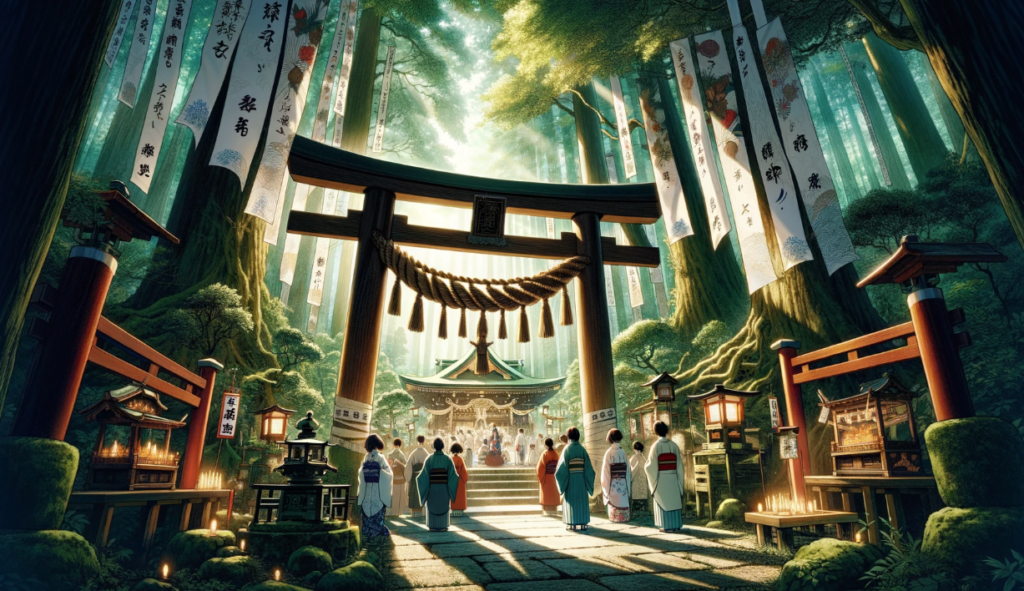
Lesson 38 Shinto
Topic Question: What is “shinto” and how does it manifest in daily life?
No. 1: Introduction – First, try answering the question yourself.
The instructor will provide advice on vocabulary, grammar, and expression corrections.
Sample Answer – Let’s read aloud. Instructor will check your pronunciation and accent.
Shinto, or the way of the gods, is the indigenous spirituality of Japan and its people. It is characterized by the worship of kami, which are spirits associated with natural phenomena, ancestors, and historical figures. Shinto’s influence extends beyond religious practices into daily life, reflecting in rituals, festivals, and even in the respect for nature and cleanliness. Its practices are deeply integrated into the Japanese lifestyle, evident in the numerous shrines across Japan, traditional ceremonies, and the celebration of seasonal festivals. Shinto emphasizes harmony with nature and the community, impacting environmental attitudes and social behaviors. It is not just a religion but a way of living that cherishes the coexistence with the spiritual world.
No. 2: Vocabulary Building- 5 Words to Learn and Their Meanings
Pronounce the Words Correctly (Pronunciation Training) + Make Sentences Using the Words Instantly
- Kami (神, kami): Spirits or gods in Shinto, associated with natural phenomena, ancestors, or historical figures.
“Many Japanese people visit shrines to pay respects to kami, seeking their blessings for prosperity and protection.”
- Shrines (神社, jinja): The sacred places in Shinto for worshipping kami.
“The Ise Grand Shrine is one of the most significant and revered Shinto shrines in Japan, attracting millions of pilgrims annually.”
- Rituals (儀式, gishiki): A set of actions performed mainly for their symbolic value, prescribed by a religion or by the traditions of a community.
“Traditional Shinto rituals often involve offerings, prayers, and dances to honor and appease the kami.”
- Festivals (祭り, matsuri): Public celebrations or gatherings in Japan, often with religious significance in Shinto, celebrating the seasons, kami, or historical events.
“The Gion Matsuri, celebrated in Kyoto, is one of the most famous Shinto festivals, known for its elaborate floats and processions.”
- Purity (清浄, seijō): The state of being physically and spiritually clean, an essential aspect of Shinto practices.
“Purification rituals are common in Shinto to cleanse the body and spirit before participating in ceremonies or entering sacred spaces.”
No. 3: Key Idiom and Example Sentences
“To live in harmony with nature” (自然との調和を生きる) – This phrase captures the essence of Shinto, emphasizing the importance of coexisting peacefully with the natural world and its spirits.
“Shinto teaches us to live in harmony with nature, respecting every mountain, river, and forest as the dwelling places of kami.”
“In daily life, this principle can be observed in the meticulous care Japanese people take of their surroundings, embodying a profound respect for nature.”
No. 4: Discussion and Exchange of Opinions on the Sample Answer
Instructor: How does Shinto influence modern Japanese society, especially in the context of technology and urbanization?
Student: [Opinions of students]
No. 5: Free Discussion on the Topic
Let’s explore further how Shinto’s emphasis on nature and purity is reflected in contemporary Japanese culture. Consider how traditional Shinto values coexist with the fast pace of modern life. How are festivals, rituals, and daily practices adapting to the modern world? Discuss the role of shrines in urban settings and how they serve as a connection to nature and tradition amidst city life. Additionally, contemplate the future of Shinto in preserving Japanese cultural identity and environmental consciousness.







